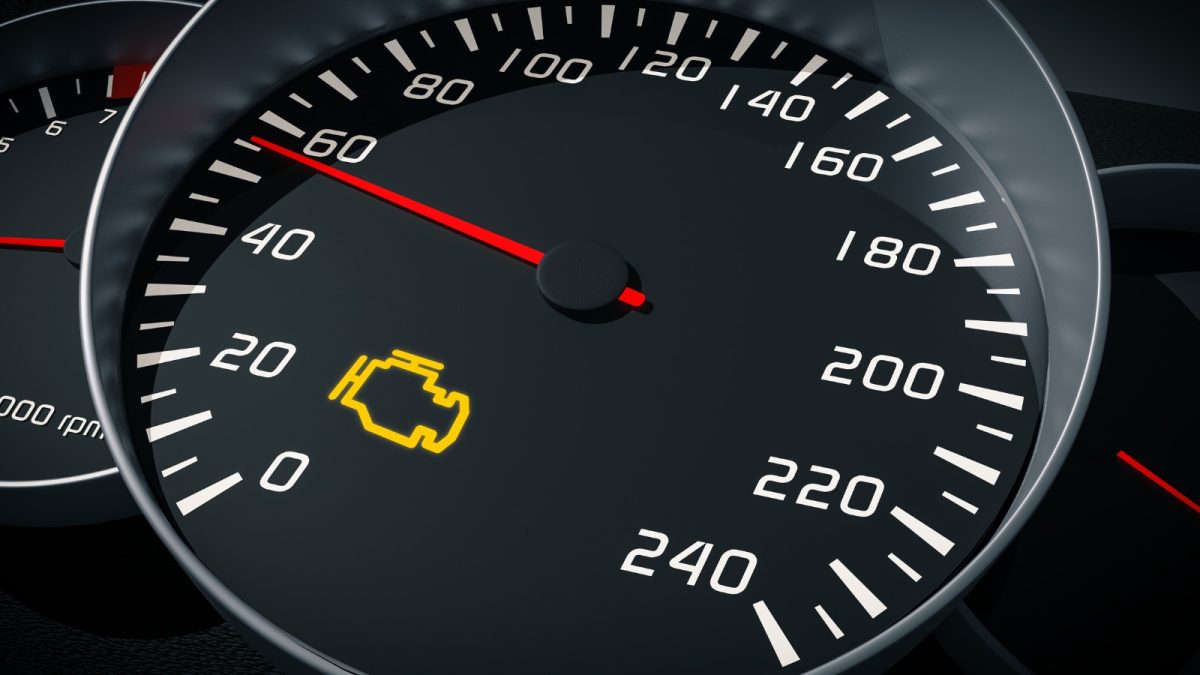Check Engine Light Quick Facts
- A check engine light signals issues from minor to severe. A flashing light means stop driving immediately.
- Diagnose problems using OBD-II codes from a mechanic, auto parts store, or scanner.
- Fix warnings promptly to avoid costly repairs and inspection failures. Ignoring the light risks greater damage and expense.
Seeing a car’s check engine light on can cast a feeling of dread for drivers who equate the symbol with costly repairs. The warning light indicates a malfunction with one of the vehicle’s systems, but even minor problems can trigger an alert.
If your check engine light is flashing, there is a serious issue, and you should turn off the engine as soon as it’s safe to get off the road. After stopping your car, you will want to know why the warning light is on in the first place and how to fix the cause.
Continue reading to learn more about what triggers the check engine light, how to diagnose the warning, and what to do when your check engine light is on.
- What Makes a Check Engine Light Come On
- Check Engine Light Warning
- Don’t Ignore Check Engine Light
- Common Check Engine Light Causes
- Diagnose Check Engine Light Problems
- Reset Engine Warning Light
- Bottom Line on Your Check Engine Light
What Makes a Check Engine Light Come On
A check engine light notifies the driver that something isn’t functioning the way it should. Known technically as the malfunction indicator lamp (MIL), this warning light in your instrument cluster is in the shape of a car engine. The light can be orange, red, or yellow, depending on your vehicle. Some models display “check engine” with the engine outline.
Sensors monitor the many complex functions in your engine. The automobile’s system receives information from the sensors to self-diagnose internal problems. For model years 1996 and later, carmakers use the second generation of standardized on-board diagnostics, also known as OBD-II. Older cars use an earlier iteration of the OBD protocol.
If sensors detect information that falls outside a normal range, the system creates an OBD-II code, which activates the check engine light.
- Check engine light flashing: A blinking or flashing check engine light indicates an issue severe enough to damage critical systems like the catalytic converter or internal engine, fuel, electrical, or air induction systems.
- Check engine light solid: When the check engine light turns on and stays on, the issue is typically related to emissions systems or some safety-related faults.
Don’t confuse the check engine light with your car’s maintenance required or service required light. This service notification, shaped like a wrench, alerts you that an oil change or other scheduled maintenance is due.
RELATED: Car Warning and Dashboard Lights Explained
Check Engine Light Warning
Drivers should understand the meaning of warning lights that signal problems with their vehicles. The owner’s manual illustrates where the symbols appear on your gauge panel and helps you interpret their meaning. Take this information seriously and pay attention to any warning light that comes on.
Never Ignore Check Engine Light
When the light comes on, take the car to a mechanic and address the problem. If you do your own investigation and determine the code that causes the warning, search a list of OBD-II codes to tell you which specific component has an issue. Read more about diagnostics in a section below.
Not every check engine warning light generates big bills. Sometimes the problem is as simple as tightening the fuel cap. Others can mean more significant issues at hand, especially when accompanied by oil or temperature warning lights. You should immediately stop the vehicle in a safe area and turn off the engine if the oil or temperature lights come on. Oil starvation or high engine temperature conditions can irreparably damage the engine and other components.
Can You Drive Your Car With the Check Engine Light On?
The check engine light warns a driver of a problem with the car’s emissions system or trouble with a critical internal function. Address the issue as soon as possible. If the light comes on and is steady, you can drive until you fix the problem. A flashing check engine light indicates a serious problem, and you should not drive the vehicle.
MORE: Car AC Not Blowing Cold Air: Possible Causes and Solutions
Common Check Engine Light Causes
The check engine light can come on for many reasons. Here are some common problems that diagnostic codes signal. Repair costs range from free or cheap to expensive. Ignoring the issue or delaying the repair might cause greater damage. Costs vary depending on the vehicle, your region, and the parts used. These general estimates are for work performed at dealerships using OEM parts.
- Loose gas cap: A loose cap can affect the evaporative emissions system. Tighten the cap for free or replace it for about $25.
- Oxygen sensor: Upstream oxygen sensors help your engine maintain fuel efficiency by adjusting the air-fuel mixture, while downstream sensors monitor the catalytic converter’s performance to ensure your car meets emissions standards. Replace a faulty sensor for about $350.
- Evaporative emissions purge valve: The purge valve is part of the vehicle’s EVAP system. It opens to direct fuel vapor into the engine for combustion instead of releasing into the atmosphere. Replacing the valve costs about $350.
- Spark plugs/plug wires: Worn spark plugs and plug wires can cause engine misfires, reducing performance, increasing emissions, and potentially sending unburned fuel into the catalytic converter, risking costly damage. Replace for about $400.
- Fuel injectors: As with bad spark plugs, faulty fuel injectors can make the engine misfire, which reduces performance and can cause expensive damage. Replacement costs about $1,200.
- Mass airflow sensor: A faulty MAF sensor can cause poor engine performance, rough idling, and reduced fuel economy by disrupting the air-fuel mixture. Replace it for about $500.
- Thermostat: A faulty thermostat can trigger the check engine light by causing engine temperature issues, which can lead to overheating, poor fuel economy, increased emissions, and even severe engine damage. Replacing a thermostat can cost about $600.
- Catalytic converter: A functioning catalytic converter is essential for meeting emissions regulations and protecting air quality. If it fails, replacement can cost $2,000 or more, making it one of the most expensive components for your car.
Except for tightening a loose gas cap, many drivers lack the skills and tools to fix problems that make a check engine light come on. Identifying the reason for the warning requires a specialized gadget that most people don’t have in their toolboxes.
RELATED: Car Tune-Up: A Checklist for Success
Diagnose Check Engine Light Problems

Today’s new cars have increasingly sophisticated computer systems. Your vehicle’s diagnostic codes are accessed using an OBD-II scanner or reader that connects to a 16-prong port usually located beneath the steering column. You have three options to obtain the code that triggered the check engine light.
- Find a car repair shop that will run their scanners to diagnose the issue for a fee, generally less than $100. Shops usually waive diagnostic fees if you have the corrective service done at that location.
- Go to an auto parts store and have the trouble code read at no charge. If the code indicates a minor problem, you might be able to fix it yourself.
- Purchase an OBD-II scanner at your auto parts store or online. Note that OBD-II is sometimes written as OBD2 or OBDII.
Choosing OBD-II Scanners
When shopping for an OBD-II scanner, consider how quickly it delivers results, how easy it is to use, and the depth of information it provides. Bluetooth models usually offer advanced features and a user-friendly app interface, though they may require more setup time. Look for helpful extras like smog check readiness, built-in diagnostic tests, and compatibility with your vehicle. For corded scanners, make sure the cable is long enough for convenient use. Remember, some basic models only display simple error codes, which may be enough for quick fixes but can be limiting if you want more detailed insights into your car’s health. Choose a scanner that matches your comfort level and diagnostic needs.
Can I Rent a Check Engine Light Reader?
No, but you can buy an OBD-II scanner for less than $50 from an auto parts store or an online retailer. A reader can be a handy tool to have in your garage, even if you don’t do much DIY work on your car. Alternatively, most auto parts stores will do a diagnostic scan on your car for free.
MORE: How Do I Know If My Spark Plugs Need Replacing?
Turn Off Check Engine Light
If your state requires an annual vehicle inspection, you’ll need to take care of the problem behind the warning light beforehand. A car will not pass inspection if the check engine light is steady or flashing.
If a mechanic fixes the cause of the check engine warning on your car, they should reset the diagnostic system to clear any codes. Most OBD scanners on the market will clear and reset codes that make the check engine light come on, even if you haven’t fixed the issue. Ignoring the root cause of an engine warning light when it turns on can create even more problems and significant expenses.
Bottom Line on Your Check Engine Light
A check engine light can signal anything from a simple fix to a serious, costly issue, so it’s important not to ignore it. Diagnosing the cause — whether with a mechanic, an auto parts store, or your own OBD-II scanner — can help you address problems early, avoid expensive repairs, and keep your vehicle running safely and in compliance with emissions regulations.
Editor’s Note: This article has been updated since its initial publication.








